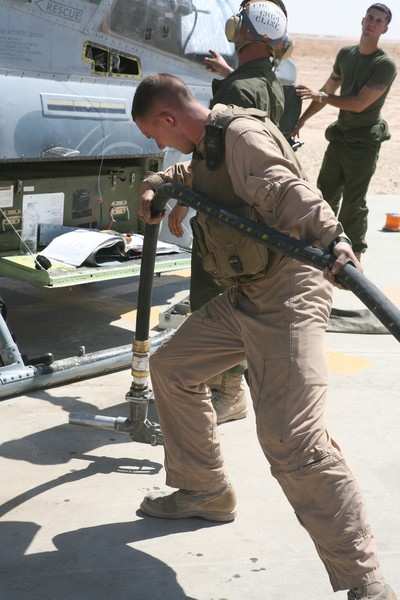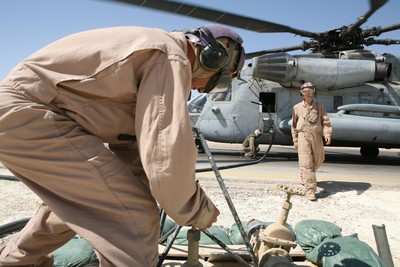 Throughout Iraq there
are two things that keep squadron’s generators burning and
their aircraft engines turning, the JP-8 fuel which powers
everything from lights to F/A-18s and the Marine refuelers who
ensure everyone receives the fuel they need.
Throughout Iraq there
are two things that keep squadron’s generators burning and
their aircraft engines turning, the JP-8 fuel which powers
everything from lights to F/A-18s and the Marine refuelers who
ensure everyone receives the fuel they need.
The refuelers of Marine Wing Support Squadron 271 man the hot
pits and work the mobile fuel trucks to deliver fuel to the fixed
and rotary wing aircraft squadrons flying in and out of Al
Asad.
“Our mission out here is to make sure aircraft get the
fuel they need so they can accomplish their mission,” said
Cpl. Fernando Horta, a motor transportation refueler with
MWSS-271.
The mobile refuelers top off the squadron’s aircraft
before they leave on missions for power support equipment such as
generators and lights. The mobile refueling is known as cold
fueling because the aircraft are not powered up while receiving
fuel.
The mobile refueling trucks carry up to 5,000 gallons of fuel
and go through approximately six loads of fuel a day supporting the
12 aircraft squadrons on Al Asad. The refuelers of ‘271
rotate eight drivers per 24 hour shift, with each driver delivering
fuel with their own truck during the day. During low light hours
the drivers double up on trucks to maximize safety.
“The CH-46 squadron will call in about seven birds at
once,” said Horta, a West Newark, NJ native. “We can
refuel all of them and still have about half a tank in the
truck.”

The other part of the refueling section consists of the bulk
fuel specialists who work the hot pits. The hot pits are fueling
stations utilized by aircraft in between missions, enabling them to
take off again at a moments notice. There are four different
stations in the hot pits, each designated for a specific types of
aircraft.
The bulk fuel specialists wait for fuel requests before heading
out to the fueling stations, once an aircraft pulls into a pit the
Marines ground the bird and begin fueling.
“We do hot fuel, which means the engines on the aircraft
are running while taking fuel,” said Sgt. David A. Owens Jr.,
a bulk fuel specialist with ‘271. “If it’s a slow
tempo we wait to be dispatched to the birds, but there are times
when you’ll be out refueling for five hours at a time.
You’ll be fueling the last C-130 and then you can see lights
from an A-10 pulling up behind it.”
Combined, the refuelers of ‘271 pump about 150,000 gallons
of fuel a day.
“Everyone that flies can go to the pits or request cold
fuel,” said Chief Warrant Officer McGill Howard, MWSS-271
fuels officer in charge. “The difference is the wait time for
the truck to get out to the aircraft. It’s a first call first
serve basis for cold fuel. Also, the trucks go out with only around
4,500 gallons so we encourage large aircraft to go to the
pits.”

There are many differences between the mobile refuelers who work
with the fuel and mechanical equipment and the bulk fuelers who are
exposed to hazards like spinning aircraft rotors and exhaust from
the aircraft, but both are dirty jobs and both get taken care
of.
“We keep the aircraft in the air so they can support the
Marines outside on the ground,” said Cpl. John Ritter, a
motor transportation refueler with 271. “If they don’t
have any fuel, they don’t have any flight time.” [ANN
salutes Cpl. Ryan R. Jackson, 2nd Marine Aircraft Wing]
 ANN's Daily Aero-Term (04.20.24): Light Gun
ANN's Daily Aero-Term (04.20.24): Light Gun Aero-News: Quote of the Day (04.20.24)
Aero-News: Quote of the Day (04.20.24) ANN's Daily Aero-Linx (04.21.24)
ANN's Daily Aero-Linx (04.21.24) Aero-News: Quote of the Day (04.21.24)
Aero-News: Quote of the Day (04.21.24) ANN's Daily Aero-Term (04.21.24): Aircraft Conflict
ANN's Daily Aero-Term (04.21.24): Aircraft Conflict





